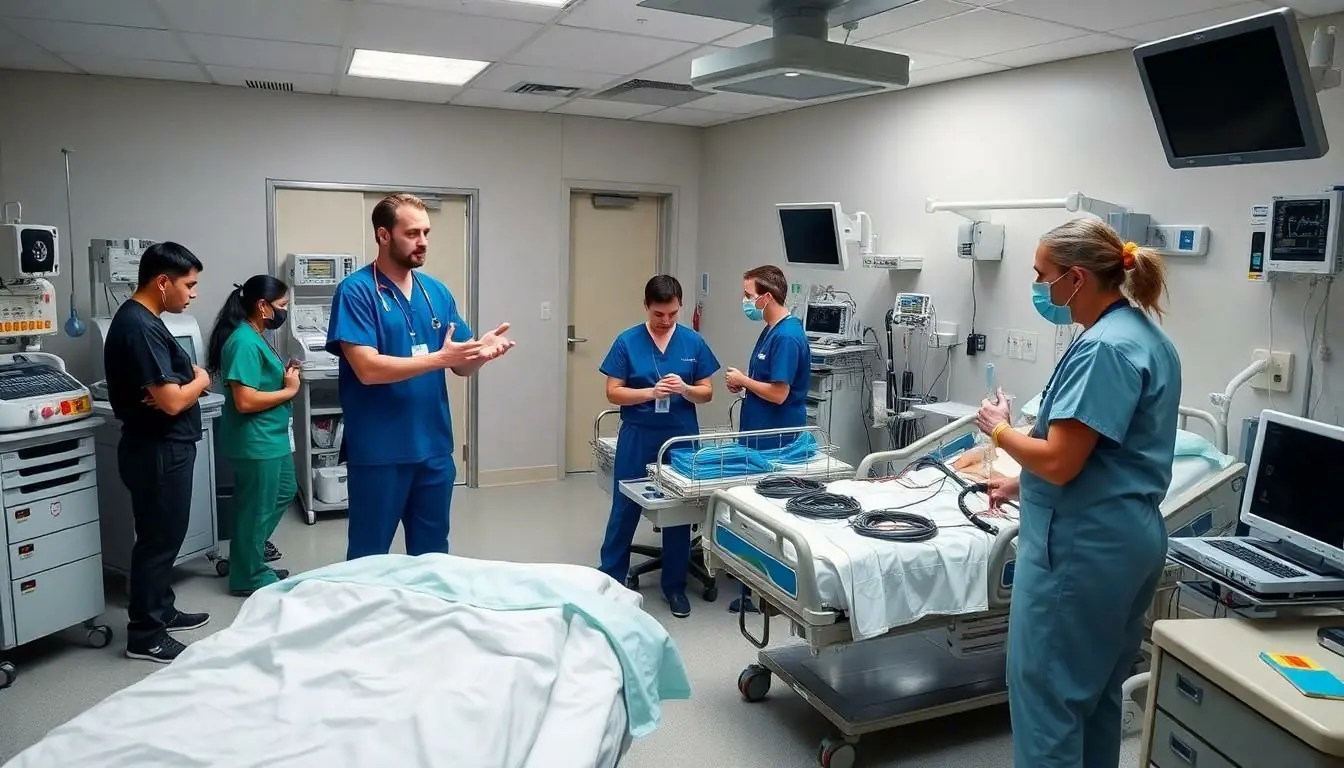Working in an emergency room isn’t just about dramatic scenes from medical TV shows – it’s an adrenaline-pumping career where every day brings new challenges and opportunities to save lives. From nurses and physicians to technicians and support staff, ER professionals form a dynamic team that keeps the heart of urgent care beating.
The emergency department offers diverse career paths for healthcare enthusiasts who thrive under pressure and want to make a real difference. Whether it’s treating life-threatening injuries stabilizing critical patients or providing compassionate care during someone’s worst moments these roles require quick thinking and unwavering dedication. With healthcare demand steadily rising emergency medicine continues to be one of the fastest-growing sectors in the medical field.
Table of Contents
ToggleWhat Are Emergency Room Jobs
Emergency room jobs encompass a range of healthcare positions focused on providing immediate medical care to patients with acute illnesses or injuries. These roles operate within a fast-paced environment where medical professionals work together to assess diagnose and treat emergency medical conditions.
Key Roles and Responsibilities
Emergency room teams include physicians technicians nurses administrative staff social workers. Each role carries specific duties:
- Emergency Room Physicians examine patients diagnose conditions perform procedures coordinate treatment plans
- ER Nurses administer medications monitor vital signs assist with procedures triage patients
- Emergency Medical Technicians provide initial patient care transport patients stabilize conditions before hospital arrival
- Registration Staff collect patient information process insurance verify identification manage documentation
- Radiology Technicians operate imaging equipment perform X-rays CT scans ultrasounds
- Social Workers arrange follow-up care coordinate resources assist with discharge planning
- Security Personnel maintain safety manage difficult situations protect staff patients
Required Skills and Qualities
- Clinical Expertise in emergency medicine procedures protocols treatments
- Critical Thinking to make quick accurate decisions under pressure
- Communication Skills for clear coordination with team members patients families
- Physical Stamina to work 12-hour shifts stand long periods lift patients
- Emotional Resilience to handle trauma death high-stress situations
- Time Management to prioritize cases handle multiple patients simultaneously
- Technical Proficiency with medical equipment electronic health records systems
- Cultural Awareness to provide care for diverse patient populations
Types of Emergency Room Careers
Emergency departments employ diverse medical professionals specialized in acute care medicine. The roles range from direct patient care providers to essential support personnel who ensure smooth operations.
Medical Professionals
Emergency room physicians lead trauma teams managing critical cases through rapid diagnosis treatment protocols. ER nurses provide direct patient care coordinate treatment plans monitor vital signs administer medications. Physician assistants perform medical procedures order diagnostic tests interpret lab results under physician supervision. Nurse practitioners conduct patient assessments prescribe medications provide follow-up care independently. Emergency medical technicians stabilize patients during transport assist with procedures perform basic life support. Clinical specialists like respiratory therapists pharmacists radiologic technologists deliver specialized diagnostic therapeutic services.
Support Staff Positions
Registration staff gather patient information process insurance verify demographics manage admissions. Unit secretaries coordinate communications schedule tests maintain medical records organize supplies. Environmental services teams sanitize rooms dispose of medical waste maintain infection control standards. Security officers ensure facility safety manage crowd control respond to disturbances protect staff patients. Social workers assist with discharge planning connect patients to community resources provide crisis intervention. Patient care technicians transport patients collect specimens assist with personal care take vital signs. Administrative coordinators oversee scheduling staffing workflow documentation compliance protocols.
Education and Training Requirements
Emergency room positions demand specific educational pathways and certifications based on the role. These requirements vary from entry-level support positions to advanced medical practitioners.
Academic Qualifications
Emergency room physicians complete a Doctor of Medicine (MD) or Doctor of Osteopathic Medicine (DO) degree, followed by 3-4 years of residency training in emergency medicine. Registered nurses obtain a Bachelor of Science in Nursing (BSN) degree through a 4-year program. Emergency medical technicians earn an associate degree in emergency medical services, while physician assistants complete a master’s degree program spanning 2-3 years. Support staff positions, such as registration clerks or patient care technicians, require a high school diploma or associate degree. Administrative roles typically need a bachelor’s degree in healthcare administration or related fields.
Certifications and Licenses
Medical professionals in emergency departments maintain role-specific certifications. Physicians obtain board certification from the American Board of Emergency Medicine. Nurses secure state licensure plus specialty certifications like Certified Emergency Nurse (CEN) or Trauma Certified Registered Nurse (TCRN). EMTs acquire National Registry Emergency Medical Technician certification at basic, intermediate or paramedic levels. Medical technicians obtain certifications from organizations like the American Society for Clinical Pathology. All clinical staff complete Basic Life Support (BLS) certification, while advanced practitioners maintain Advanced Cardiac Life Support (ACLS) credentials. Support staff complete relevant certifications in medical coding, billing or healthcare privacy compliance.
Working Conditions in the ER
Emergency room environments operate 24/7 with high-intensity patient care demands. The dynamic nature of emergency medicine creates unique working conditions that require adaptability and resilience from healthcare professionals.
Shift Patterns and Schedules
ER staff work rotating shifts covering 24-hour operations through 8-12 hour schedules. Day shifts typically run from 7 AM to 7 PM while night shifts operate from 7 PM to 7 AM. Medical professionals rotate between morning afternoon evening schedules in 3-4 week blocks. Weekend rotations occur every 2-3 weeks with staff working 3-4 shifts per week. Holiday coverage follows an equitable distribution system ensuring continuous patient care. Some facilities implement flexible scheduling options including self-scheduling systems compressed workweeks swing shifts.
Physical and Emotional Demands
ER work involves constant movement lifting transferring patients standing for 12-hour periods. Staff handle 15-30 patients per shift requiring quick transitions between multiple cases simultaneously. The environment exposes workers to infectious diseases bodily fluids traumatic injuries. Emotional challenges include dealing with death critical injuries aggressive patients family grief. Mental stamina proves essential when making rapid decisions under pressure throughout busy shifts. Healthcare workers face compassion fatigue from repeated exposure to trauma crisis situations. Regular exposure to high-stress scenarios demands effective coping mechanisms stress management techniques.
Salary and Career Growth
Emergency room positions offer competitive salaries that reflect the demanding nature of the work and required expertise. The compensation varies based on role, experience, location and facility type.
Compensation Ranges
Emergency room physicians earn $285,000 to $450,000 annually, while emergency nurse practitioners make $98,000 to $120,000. ER registered nurses receive $65,000 to $95,000 per year based on experience level. Emergency medical technicians earn $35,000 to $50,000 annually. Support staff salaries range from $30,000 to $45,000 for roles like registration specialists and unit secretaries.
| Position | Salary Range |
|---|---|
| ER Physician | $285,000 – $450,000 |
| Nurse Practitioner | $98,000 – $120,000 |
| Registered Nurse | $65,000 – $95,000 |
| EMT | $35,000 – $50,000 |
| Support Staff | $30,000 – $45,000 |
Advancement Opportunities
Career progression in emergency medicine includes clinical leadership roles like department chief, nurse manager or EMS director. Advanced certifications enable specialization in areas like trauma, pediatric emergency care or flight medicine. Educational paths lead to positions such as clinical educator, research coordinator or quality improvement specialist. Administrative tracks offer growth into operations management, emergency preparedness coordination or healthcare administration. Fellowship programs provide additional training in toxicology, ultrasound or disaster medicine.
Conclusion
Emergency room jobs offer rewarding career paths for individuals passionate about providing critical care in fast-paced environments. From physicians and nurses to technicians and support staff each role contributes to saving lives and making a difference in healthcare delivery.
The field continues to grow with competitive salaries excellent benefits and numerous opportunities for advancement. While the work demands physical stamina emotional resilience and technical expertise healthcare professionals who choose this path find deep satisfaction in their ability to help others during their most vulnerable moments.
For those considering a career in emergency medicine the combination of challenging work collaborative environments and meaningful impact makes it an excellent choice in healthcare.




